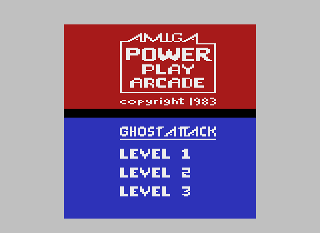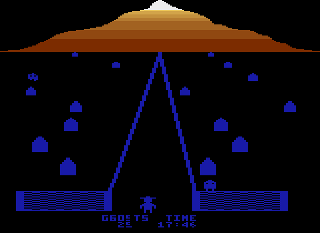|
|
3-D Ghost Attack
According to the manual that came with the
reproduction sold a few years back, you have decided to
check out the local mansion to see if it’s really
haunted or not. Armed only with your photobeam
(I’m guessing this a fancy way of saying flashlight),
you must make your way through the mansion and discover…
something. The manual isn’t really clear on this
point. Let’s just say that you’ve decided to take
on a bunch of ghosts that are haunting a mansion because
they’ve got to die (again). Yeah, that sounds a
bit more interesting.
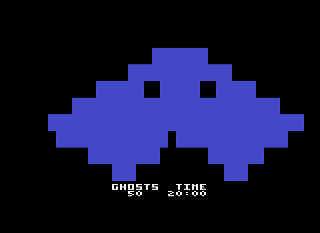 Of the three 3-D Amiga games, Ghost Attack is the least complete. Originally three different prototypes (each prototype containing one level), they were ‘stitched together’ using the menu system from the Power Play Arcade Series prototype. However each stage is in a different state of completion, so although the game can be played to a degree, it cannot be played all the way through. This is a shame as 3-D Ghost Attack is probably the most interesting of the three.
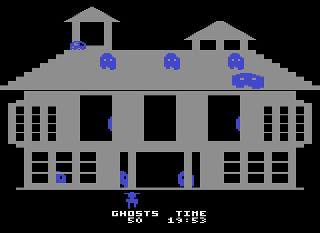 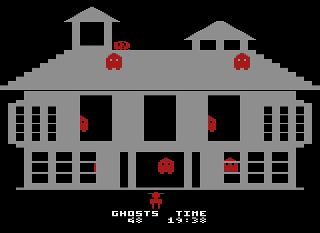 Although the screen shows that you must destroy 50 ghosts in 20 minutes, you’ll automatically move to the next stage after a few minutes. The second stage takes place in a graveyard, but your goal and controls are the same. One thing to note is that there are fewer ghosts on this stage and they’re spread further out. Unfortunately since this stage has no collision detection (or sound for that matter) it cannot be played. Your only choice to go back to the menu and select another stage. It’s assumed that had the game been completed you would be moved to the next stage after killing the requisite number of ghosts. Interestingly it appears that your character can move a bit forward down the path (up to the first set of ghosts), and will be knocked back if they touch him. Perhaps you were meant to slowly go down the road after shooting each batch of ghosts? On a side note this stage features a really nice 3-D perspective that actually works pretty well, unlike the other stages.
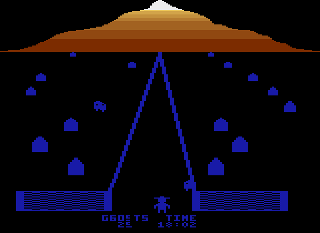
The third stage takes place in the portal to the
ghost world (which looks suspiciously like a 3-D
cube). Here you must shoot as many ghosts as you
can before they escape out into the world. This is
easier said than done as they move very fast and are not
in any pattern. This stage also has your shots
'move' inwards towards the center of the screen to
simulate shooting into the distance, this can make it
hard to line up your shots. Unfortunately this
stage doesn’t have an ending so it will continue forever
until you give up. Apparently there is some code
for an ending tune but it’s not accessible in this
prototype.
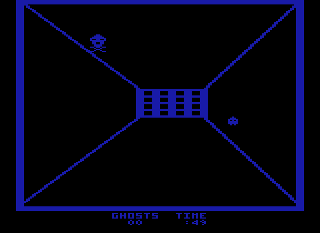
The history of 3-D Ghost Attack is interesting. Originally planned to be a pack-in game for the cassette based Amiga Power Module (a Supercharger type unit), it was then moved to the Power Play Arcade series of multicarts (see this page for more information). 3-D Ghost Attack would have been teamed up with 3-D Genesis and 3-D Havoc on Power Play Arcade cart #1 (5 carts were planned in total). The current rom is actually a hack of the Power Play Arcade cart, with the individual levels selectable by the main menu and the levels converted to conventional bankswitching schemes. This has to be done to make the game playable as the special bank switching of the PPA cart was not supported at the time. Unfortunately no known dump of 3-D Ghost Attack in its original form seems to exist.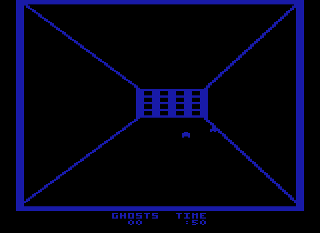 Had it been released, 3-D Ghost Attack would have been the first 3-D game on the 2600. It’s unknown why Amiga decided to put three full games on one cart as any one of these games could have stood on their own, but it would have been a real deal for the penny conscious gamer. Perhaps Amiga knew that the market was becoming cluttered and thought that offering several games on one cartridge was a way to stand out from the crowd (Xonox did something similar with their double enders). Whatever the reason it was all for naught as the project was cancelled before getting out the door due to Amiga’s decision to stop with the games and focus on a little computer that they’d been developing instead...
|

